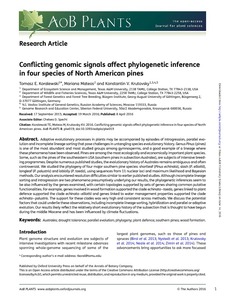Conflicting genomic signals affecting phylogenetic inference in four species of North American pines
URI (для ссылок/цитирований):
https://elib.sfu-kras.ru/handle/2311/32963Автор:
Koralewski, T. E.
Mateos, M.
Krutovsky, K. V.
Коллективный автор:
Институт фундаментальной биологии и биотехнологии
Базовая кафедра защиты и современных технологии мониторинга лесов
Дата:
2016-04Журнал:
AoB PLANTSКвартиль журнала в Scopus:
Q1Квартиль журнала в Web of Science:
Q2Библиографическое описание:
Koralewski, T. E. Conflicting genomic signals affecting phylogenetic inference in four species of North American pines [Текст] / T. E. Koralewski, M. Mateos, K. V. Krutovsky // AoB PLANTS. — 2016. — Т. 8 (plw019). — С. 1-12Текст статьи не публикуется в открытом доступе в соответствии с политикой журнала.
Аннотация:
Adaptive evolutionary processes in plants may be accompanied by episodes of introgression, parallel evolution and incomplete lineage sorting that pose challenges in untangling species evolutionary history. Genus Pinus (pines) is one of the most abundant and most studied groups among gymnosperms, and a good example of a lineage where these phenomena have been observed. Pines are among the most ecologically and economically important plant species. Some, such as the pines of the southeastern USA (southern pines in subsection Australes), are subjects of intensive breeding programs. Despite numerous published studies, the evolutionary history of Australes remains ambiguous and often controversial. We studied the phylogeny of four major southern pine species: shortleaf (Pinus echinata), slash (P. elliottii), longleaf (P. palustris) and loblolly (P. taeda), using sequences from 11 nuclear loci and maximum likelihood and Bayesian methods. Our analysis encountered resolution difficulties similar to earlier published studies. Although incomplete lineage sorting and introgression are two phenomena presumptively underlying our results, the phylogenetic inferences seem to be also influenced by the genes examined, with certain topologies supported by sets of genes sharing common putative functionalities. For example, genes involved in wood formation supported the clades echinata–taeda, genes linked to plant defence supported the clade echinata–elliottii, whereas genes linked to water management properties supported the clade echinata-palustris. The support for these clades was very high and consistent across methods. We discuss the potential factors that could underlie these observations, including incomplete lineage sorting, hybridization and parallel or adaptive evolution. Our results likely reflect the relatively short evolutionary history of the subsection that is thought to have begun during the middle Miocene and has been influenced by climate fluctuations.

